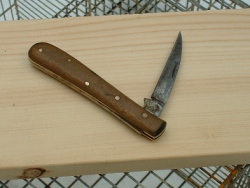
by Sean

Grafting Knife
I would appreciate your expertise in answering some questions concerning grafting. I think that I erroneously believed that if you graft a branch from one type of tree to another type of tree, that the grafted branch would bear the type of fruit of the tree into which it was grafted. Is that ever possible? To be more clear, if you graft a Granny Smith branch into a Braeburn Tree, would the Granny Smith branch bear Braeburn Apples or Granny Smith apples? Could it ever be possible for the Granny Smith branch to bear Braeburn Apples, since it is grafted into the Braeburn tree?
Also, can you graft, say a peach branch, into an apple tree and it bear fruit? If you graft a green olive branch into a black olive tree, will it produce green or black olives? Would that branch always bear green olives, or would it vary over time?
Would the host tree ever be in conflict with the grafted branch? How does the grafted branch over time maintain its own “identity”, while receiving nourishment from a different type of tree? I would think that there would be some genetic conflict.
I am just curious as to how grafting works. I hope you are able to take the time to give me some answers.
Thanks,
Sean
Hi Sean, you’ve got a lot of questions! So if I understand your first question, the scion would bear the fruit of that variety – using your example, a Granny Smith scion grafted onto root stock that is Braeburn, that branch will eventually bear Granny Smith fruit.
Although the genetics dictate that the fruit will be of that variety, the rootstock also contributes certain characteristics such as dwarfing of the tree itself. This makes it possible to have really intensive orchards with tiny trees trained onto wires, with full sized fruit.
For your second question, no. You can’t graft a branch off a peach onto an apple. They are just too far removed genetically. If you graft any kind of apple onto another apple or crabapple, that will work, and in some cases, peaches can be grafted onto other stone fruits (cherry, plum or nectarine) successfully.
Green olives are actually just immature or less ripened black olives to my knowledge, so that’s not a good example.
There have been cases of conflicts between different grafted trees – I’ve seen really old trees with what you would think are completely compatible grafts, but a windstorm took off the branch completely and cleanly, as though it really hadn’t been grafted at all. It’s a mystery how the graft managed to live so long, and actually get to a good size before the graft failed.
There isn’t so much of a genetic incompatibility, but in some cases a virus or bacterial infection can be passed along.
Hope that helps with your understanding of grafting and how it works.
Jacki
Comments for Questions Concerning Grafting
Sep 28, 2017
grafffting
by: suleman khan
graffting are takes place in some plants why is there any reason?
Sep 28, 2017
Reason for grafting
by: Jacki
Suleman, there are several reasons for grafting plants. One is that some plants are almost impossible to root by cuttings, which are the easiest method. So if they don’t root on their own roots, the next best system is to graft them onto another plants roots, which is easy to root from cuttings. Examples of this are certain cacti.
The second reason is to propagate a certain plant that is special in some way, such as the colored cacti, which also won’t grow on their own roots, due to them not containing chlorophyll (the green part) or some other reason.
The third reason is that certain types of root stock can change the way a plant grows, such as many apple varieties. These are grown on ‘dwarfing’ rootstock which keeps them small, even though when they’re grown on their own roots they’ll make a full sized tree.
Hope that helps answer your question!
Mar 14, 2021
Have not found this grafting answer
by: Ivan
Do not see anywhere how long after cutting new branch to be grafted onto receiving tree branch (Possibly keeping in water 1, 2, 3 days…), will the grafting “Take/grow?”
Immediately is best, but cutting in one Stat, grafting in another? Any “Helps” recommending in this case?>
Mar 14, 2021
Immediately
by: Jacki Cammidge, Certified Horticulturist
Putting the scion in water is not an option.
For very short periods of time, the scions will be okay in a plastic bag, possibly wrapped in (barely) damp paper towel. This is what you would need to do to get the scions home after cutting them off a plant a few kilometers away, but not for more than a few hours or over night.
Jun 05, 2021
Summer grafting of main stem?
by: Allen D
Apparently a squirrel jumped onto our new plum tree (5′ sapling) and broke off the main stem, which is in full leaf out, mid June. I put it in water, and the leaves are OK. Is there any point to try to graft it back on, or should I let another stem become the leader, and just call this an involuntary pruning?
Jun 05, 2021
Note to Allen D
by: Jacki Cammidge, Certified Horticulturist
Hey Allen, I think it would be best to do either of the latter two suggested options; train a new leader from any new growth that emerges from below the break, and/or consider it accidental pruning. Keep an eye on it, it’s still a little early in the year to be pruning stone fruits (plums, peaches, cherries etc) as the sap tends to keep running and attracts ants and pathogens.
Although you may have success with a fully leafed out scion, it’s unlikely. The time to graft trees is when they’re fully dormant, just before they start into growth.

